Performance Management General Framework
Added on 2022-12-19
37 Pages6401 Words1 Views
Running head: PERFORMANCE MANAGEMENT GENERAL FRAMEWORK
Topic 13: Performance Management General Framework
Name of the University:
Name of the Student:
Authors Note:
Topic 13: Performance Management General Framework
Name of the University:
Name of the Student:
Authors Note:

PERFORMANCE MANAGEMENT GENERAL FRAMEWORK1
Executive Summary
Performance management concept will be better analysed through explaining the positives and
negatives in the performance management approaches. The report will also consider explaining
performance management approach from a control theory perspective along with evaluating the
relevance of balance scorecard approach in ensuing better performance management in
organisations. The report revealed that is a common characteristic that is observed in the high-
performance teams is cohesiveness as it serves as a measure of interaction of the group to its
members. Balanced scorecard approach is one of the top ten widely employed management tools
all over the world, a list which encompass closely-related strategic planning at top priority.
Control theory appears to be quite mechanical with respect to human behaviour and
performance. This theory can work efficiently in a strict organisational framework in which
employee actions that are regularly monitored as well as controlled. The Balanced Scorecard
approach has several important perspectives that facilitate in better performance management of
the organisations:
Executive Summary
Performance management concept will be better analysed through explaining the positives and
negatives in the performance management approaches. The report will also consider explaining
performance management approach from a control theory perspective along with evaluating the
relevance of balance scorecard approach in ensuing better performance management in
organisations. The report revealed that is a common characteristic that is observed in the high-
performance teams is cohesiveness as it serves as a measure of interaction of the group to its
members. Balanced scorecard approach is one of the top ten widely employed management tools
all over the world, a list which encompass closely-related strategic planning at top priority.
Control theory appears to be quite mechanical with respect to human behaviour and
performance. This theory can work efficiently in a strict organisational framework in which
employee actions that are regularly monitored as well as controlled. The Balanced Scorecard
approach has several important perspectives that facilitate in better performance management of
the organisations:
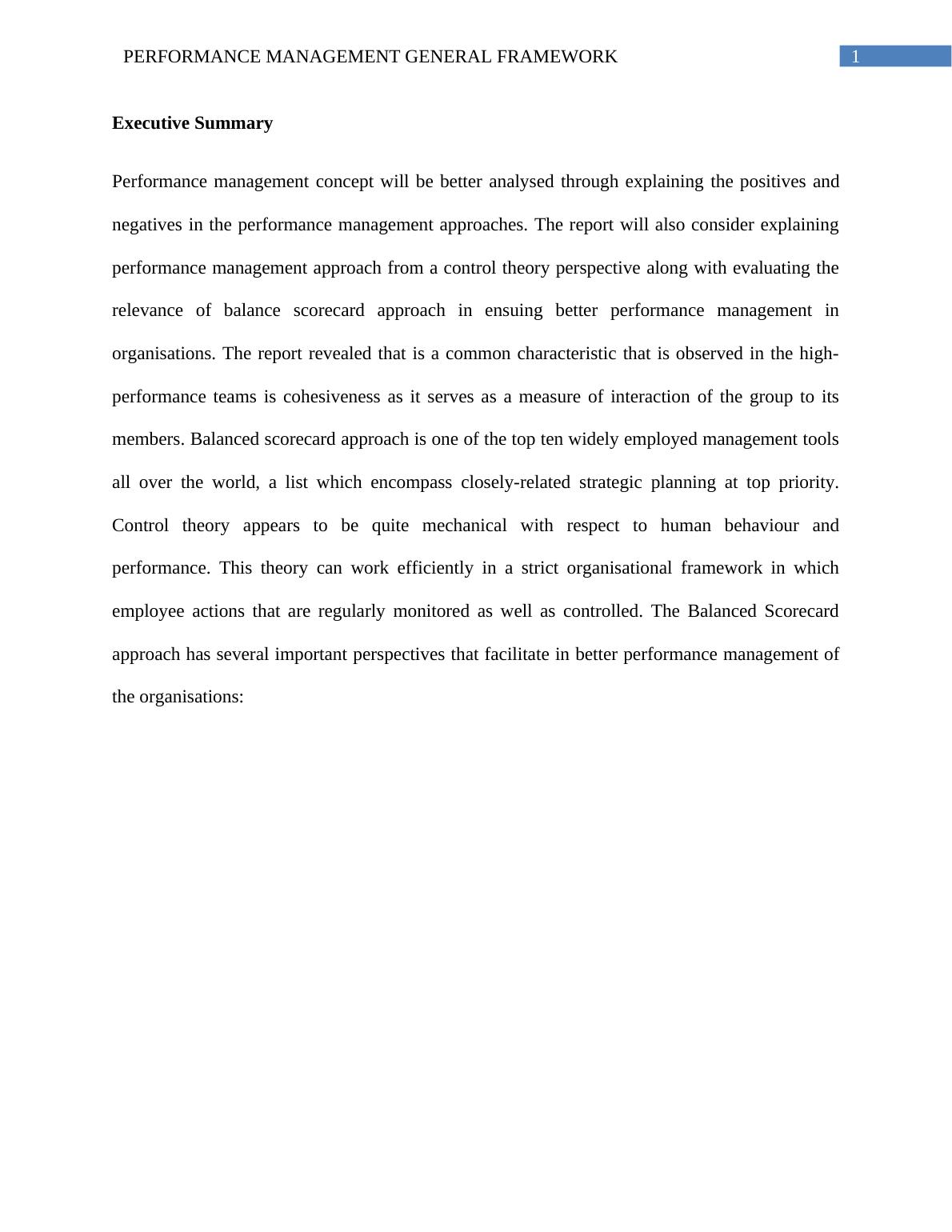
PERFORMANCE MANAGEMENT GENERAL FRAMEWORK2
Table of Contents
Introduction......................................................................................................................................4
MBO, Review and Agree, 360-degree Feedback............................................................................4
Management by Objectives (MBO).............................................................................................5
Review and Agree........................................................................................................................6
360 Degree Feedback..................................................................................................................7
Comparing Strengths and Weaknesses of Cohesive Versus Non-Cohesive Teams and
the Application to High Performance Organisations.......................................................................8
Strengths and Weakness of Team cohesiveness and Application in High Performance
Organisation.................................................................................................................................8
Strengths and Weakness of Non-Cohesive Teams and Application in High Performance
Organisation...............................................................................................................................10
Performance Management from a Control Theory Perspective....................................................11
Overview of Control Theory.....................................................................................................11
Managing Performance by Means of Control Process in the System.......................................12
Application of Control Theory within Workplace.....................................................................13
Strengths and Weakness of Control Theory..............................................................................14
The Balanced Scorecard Approach...............................................................................................15
Conclusion.....................................................................................................................................18
References......................................................................................................................................19
Table of Contents
Introduction......................................................................................................................................4
MBO, Review and Agree, 360-degree Feedback............................................................................4
Management by Objectives (MBO).............................................................................................5
Review and Agree........................................................................................................................6
360 Degree Feedback..................................................................................................................7
Comparing Strengths and Weaknesses of Cohesive Versus Non-Cohesive Teams and
the Application to High Performance Organisations.......................................................................8
Strengths and Weakness of Team cohesiveness and Application in High Performance
Organisation.................................................................................................................................8
Strengths and Weakness of Non-Cohesive Teams and Application in High Performance
Organisation...............................................................................................................................10
Performance Management from a Control Theory Perspective....................................................11
Overview of Control Theory.....................................................................................................11
Managing Performance by Means of Control Process in the System.......................................12
Application of Control Theory within Workplace.....................................................................13
Strengths and Weakness of Control Theory..............................................................................14
The Balanced Scorecard Approach...............................................................................................15
Conclusion.....................................................................................................................................18
References......................................................................................................................................19
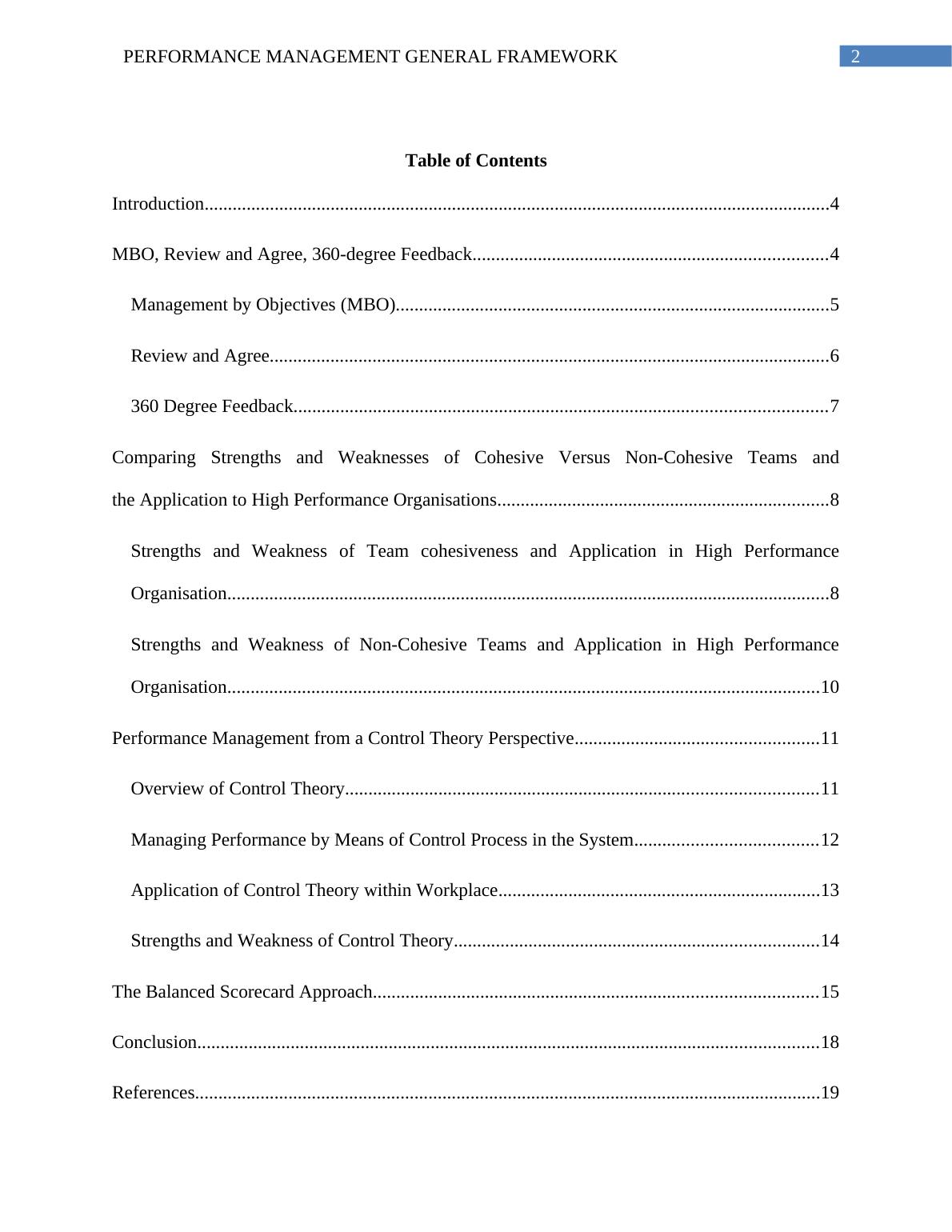
PERFORMANCE MANAGEMENT GENERAL FRAMEWORK3
Appendices....................................................................................................................................22
Appendix 1.................................................................................................................................22
Appendix 2.................................................................................................................................22
Appendix 3.................................................................................................................................23
Appendix 4.................................................................................................................................31
Appendix 5.................................................................................................................................33
Appendices....................................................................................................................................22
Appendix 1.................................................................................................................................22
Appendix 2.................................................................................................................................22
Appendix 3.................................................................................................................................23
Appendix 4.................................................................................................................................31
Appendix 5.................................................................................................................................33
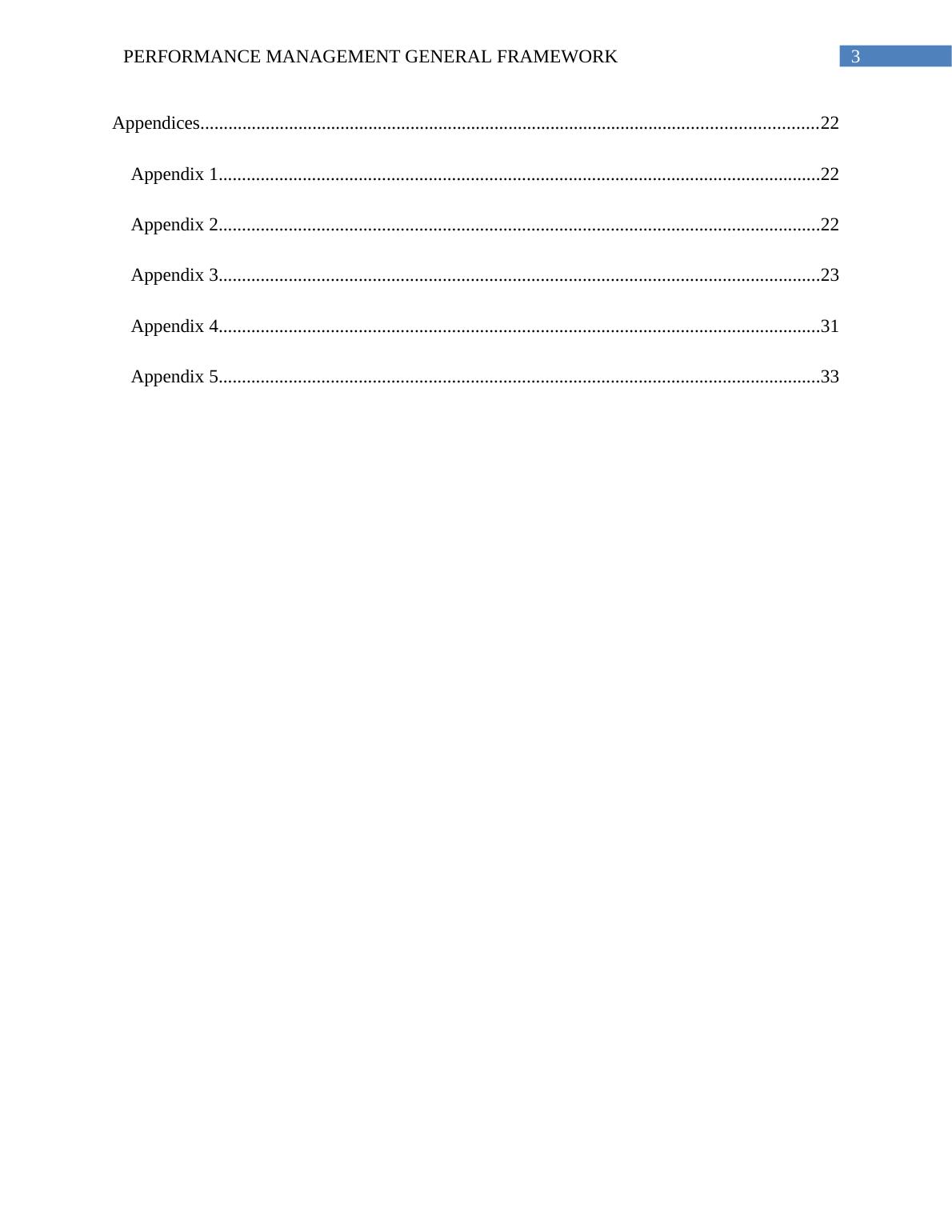
PERFORMANCE MANAGEMENT GENERAL FRAMEWORK4
Introduction
Performance management acts as set of activities which makes sure that the
organisational goals are attained in an effective manner. This process focuses on understanding
the manner in which employees contribute to attain organisational goal. An efficient
performance management along with appraisal process centres on aligning workforce,
developing competencies, enhancing employee career development and performance along with
attaining better business results (Akkermans & Van Oorschot, 2018). The performance
management framework generally focuses on measuring performance of a business, department,
employee or the processes implemented in managing specific tasks. The objective of the paper is
to analyse the concept of performance management in the context of management theory.
Performance management concept will be better analysed through explaining the positives and
negatives in the performance management approaches. In evaluating the general framework of
performance management certain individual components such as MBO, review and agree along
with 360 degree feedback will be analysed. Along with that analysing the strengths and
weaknesses of cohesive verses non-cohesive teams along with their application within the high
performance organisations will also be analysed. The report will also consider explaining
performance management approach from a control theory perspective along with evaluating the
relevance of balance scorecard approach in ensuing better performance management in
organisations.
MBO, Review and Agree, 360-degree Feedback
Alexander, Kumar & Walker, (2018) explained that performance appraisal to be a
process of performance review, performance evaluation and career development discussion
Introduction
Performance management acts as set of activities which makes sure that the
organisational goals are attained in an effective manner. This process focuses on understanding
the manner in which employees contribute to attain organisational goal. An efficient
performance management along with appraisal process centres on aligning workforce,
developing competencies, enhancing employee career development and performance along with
attaining better business results (Akkermans & Van Oorschot, 2018). The performance
management framework generally focuses on measuring performance of a business, department,
employee or the processes implemented in managing specific tasks. The objective of the paper is
to analyse the concept of performance management in the context of management theory.
Performance management concept will be better analysed through explaining the positives and
negatives in the performance management approaches. In evaluating the general framework of
performance management certain individual components such as MBO, review and agree along
with 360 degree feedback will be analysed. Along with that analysing the strengths and
weaknesses of cohesive verses non-cohesive teams along with their application within the high
performance organisations will also be analysed. The report will also consider explaining
performance management approach from a control theory perspective along with evaluating the
relevance of balance scorecard approach in ensuing better performance management in
organisations.
MBO, Review and Agree, 360-degree Feedback
Alexander, Kumar & Walker, (2018) explained that performance appraisal to be a
process of performance review, performance evaluation and career development discussion
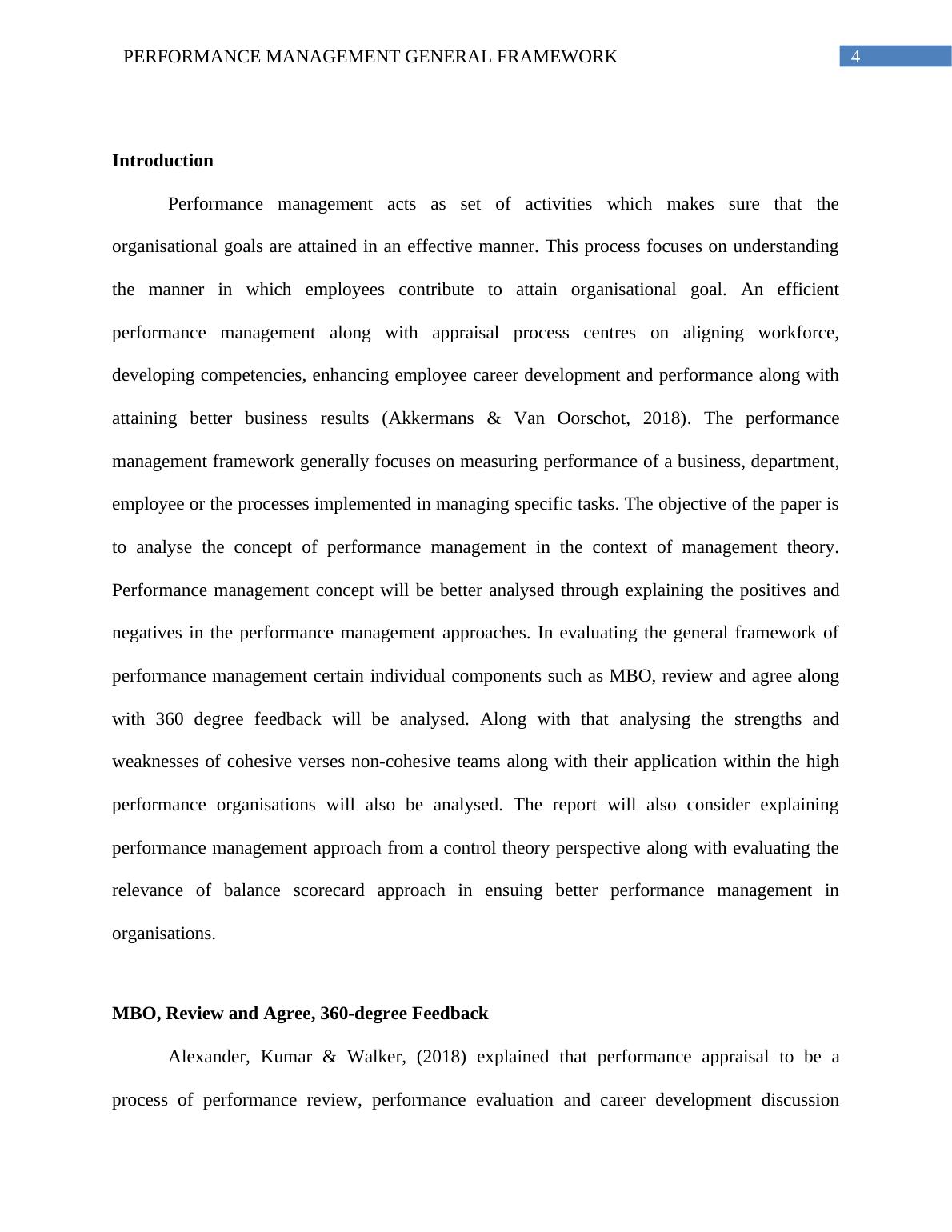
PERFORMANCE MANAGEMENT GENERAL FRAMEWORK5
through which job performance of employee can be analysed and documented. Management by
Objectives (MBO), 360 degree feedback appraisal and Review and Agree serves as future
oriented performance management methods that are employed by organisation.
Management by Objectives (MBO)
MBO is also known as management by results (MBR) that serves as process of
elaborating objectives in company so that the employees as well as the management agree to
such objectives and realise the aspect they need to achieve in order to attain the organisational
goal (Cooper & Ezzamel, 2016). This performance appraisal technique focuses on measuring
performance of employees through analysing the extent to which predetermined work objectives
are attained. Generally the subordinates and the supervisors establish such objectives jointly. The
figure below signified the MBO process cycle.
Figure 1: MBO Process Cycle
(Source: Gregory, Robbins, Schwaitzberg & Harmon, 2017)
through which job performance of employee can be analysed and documented. Management by
Objectives (MBO), 360 degree feedback appraisal and Review and Agree serves as future
oriented performance management methods that are employed by organisation.
Management by Objectives (MBO)
MBO is also known as management by results (MBR) that serves as process of
elaborating objectives in company so that the employees as well as the management agree to
such objectives and realise the aspect they need to achieve in order to attain the organisational
goal (Cooper & Ezzamel, 2016). This performance appraisal technique focuses on measuring
performance of employees through analysing the extent to which predetermined work objectives
are attained. Generally the subordinates and the supervisors establish such objectives jointly. The
figure below signified the MBO process cycle.
Figure 1: MBO Process Cycle
(Source: Gregory, Robbins, Schwaitzberg & Harmon, 2017)
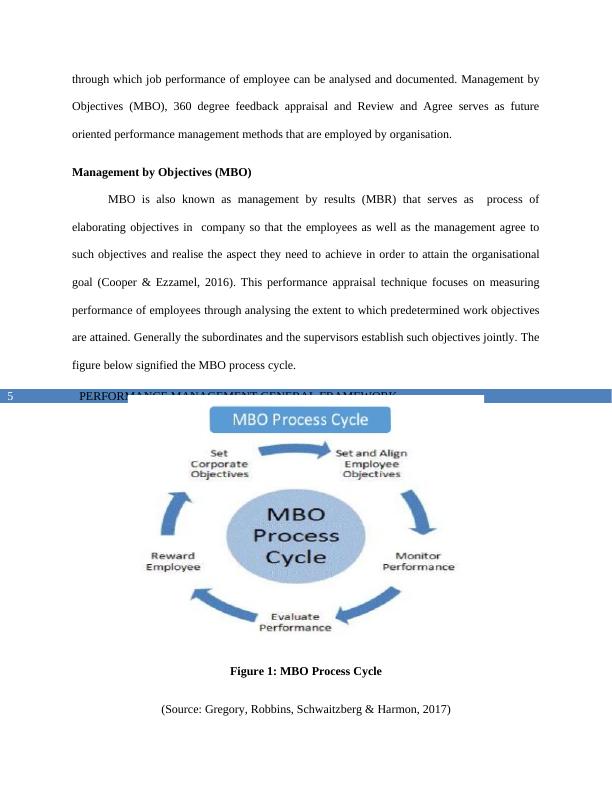
PERFORMANCE MANAGEMENT GENERAL FRAMEWORK6
Certain advantages and disadvantages related with MBO performance measurement
process are indicated below:
Advantages
This method has the ability to deal with the issue of assuming traits of employees that is
required for ensuring job success
Employees are judged based on real outcomes and not on their potential to attain success
This method also realises the fact that it is complex to aspects that impacts employee
performance (Grossman, Rosch, Mazer & Salas, 2015)
Disadvantages
This performance appraisal method can result in unrealistic expectations that might not
be reasonably attained
Subordinates and supervisors must maintain better reality checking skills to employ
MBO appraisal techniques
Review and Agree
Hansen & Schaltegger, (2016) defined review and agree as an employee performance
measurement process that is also at times referred as annual review. This offers an opportunity
for a manager along with direct report to review employees’ performance against the pre-agreed
expectations along with recognising the reason where improvements can be made. Performance
review and agree process focuses on offering fair as well as proper feedback to employees
regarding their current performance. It also focuses on recognising the weaknesses and strengths
of individual employees along with whole teams. Performance review and agree has also faced
Certain advantages and disadvantages related with MBO performance measurement
process are indicated below:
Advantages
This method has the ability to deal with the issue of assuming traits of employees that is
required for ensuring job success
Employees are judged based on real outcomes and not on their potential to attain success
This method also realises the fact that it is complex to aspects that impacts employee
performance (Grossman, Rosch, Mazer & Salas, 2015)
Disadvantages
This performance appraisal method can result in unrealistic expectations that might not
be reasonably attained
Subordinates and supervisors must maintain better reality checking skills to employ
MBO appraisal techniques
Review and Agree
Hansen & Schaltegger, (2016) defined review and agree as an employee performance
measurement process that is also at times referred as annual review. This offers an opportunity
for a manager along with direct report to review employees’ performance against the pre-agreed
expectations along with recognising the reason where improvements can be made. Performance
review and agree process focuses on offering fair as well as proper feedback to employees
regarding their current performance. It also focuses on recognising the weaknesses and strengths
of individual employees along with whole teams. Performance review and agree has also faced
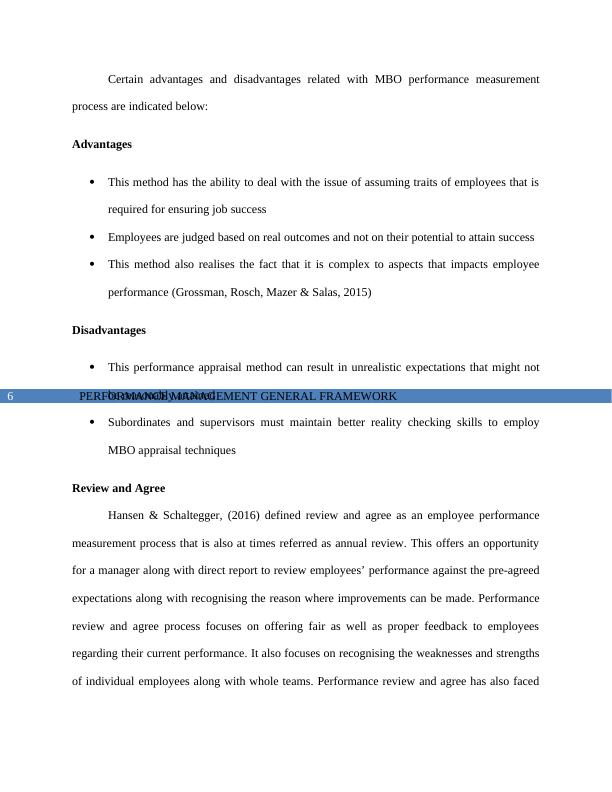
PERFORMANCE MANAGEMENT GENERAL FRAMEWORK7
certain criticisms such as it is carried out on a frequent basic and allows issues to take place in
between reviews.
360 Degree Feedback
Herbst, (2017) defined 360 degree feedback approach as a system or process in which
employees attain confidential as well as anonymous feedback from people that work around
them that can be from employees’ peers, managers and direct reports. Such feedback is basically
offered on a form of indicating job skills, capabilities along with attitudinal and behavioural
criteria. This performance measurement process also includes a type of scoring or value
judgement process by appraises peers, subordinate employees, up-line managers, employees,
consumers, suppliers and team members of employees (Kakar, 2018). This performance
measurement process also takes into account that appraise must also evaluate themselves
employing sale feedback form. The results attained from 360 degree feedback are collectively
evaluated for representing the overall situation of the company. Certain advantages and
disadvantages related with this employee performance management process are indicated below:
Advantages
This performance management process has advantages of decreasing the single rather
biases
Peer along with the subordinate review might be advantageous for development purpose
This feedback process is deemed to be fair and transparent which can encourage
development of an open culture which values attained feedbacks (Karkoulian, Assaker &
Hallak, 2016)
Disadvantages
certain criticisms such as it is carried out on a frequent basic and allows issues to take place in
between reviews.
360 Degree Feedback
Herbst, (2017) defined 360 degree feedback approach as a system or process in which
employees attain confidential as well as anonymous feedback from people that work around
them that can be from employees’ peers, managers and direct reports. Such feedback is basically
offered on a form of indicating job skills, capabilities along with attitudinal and behavioural
criteria. This performance measurement process also includes a type of scoring or value
judgement process by appraises peers, subordinate employees, up-line managers, employees,
consumers, suppliers and team members of employees (Kakar, 2018). This performance
measurement process also takes into account that appraise must also evaluate themselves
employing sale feedback form. The results attained from 360 degree feedback are collectively
evaluated for representing the overall situation of the company. Certain advantages and
disadvantages related with this employee performance management process are indicated below:
Advantages
This performance management process has advantages of decreasing the single rather
biases
Peer along with the subordinate review might be advantageous for development purpose
This feedback process is deemed to be fair and transparent which can encourage
development of an open culture which values attained feedbacks (Karkoulian, Assaker &
Hallak, 2016)
Disadvantages
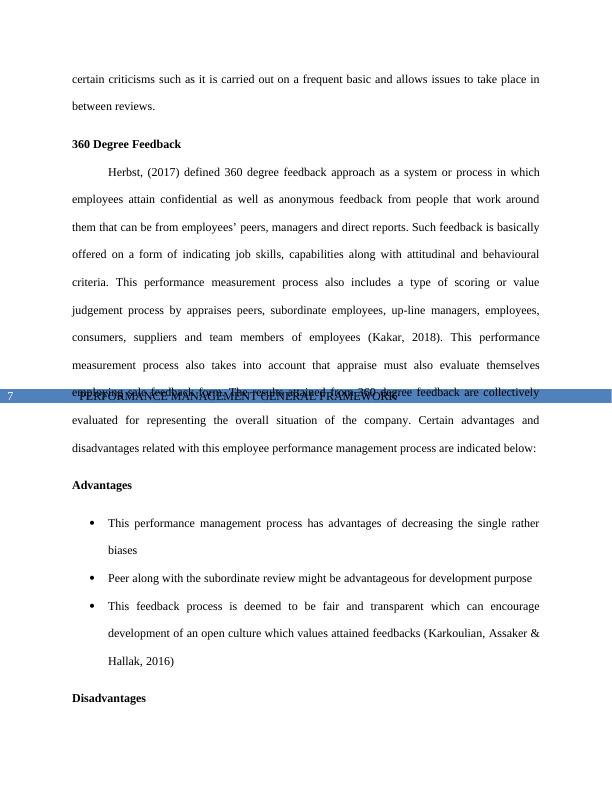
End of preview
Want to access all the pages? Upload your documents or become a member.
Related Documents
Performance Management General Frameworklg...
|11
|1073
|25
Four Criteria Used to Measure Performancelg...
|6
|916
|351
Performance Management Techniques in Burberrylg...
|10
|1789
|25
Motivational Strategy for XYZ Company - Leadership and Management Presentationlg...
|15
|1192
|322
Malcolm Baldrige Model : Essaylg...
|10
|2370
|199
Managing Human Resources: Performance Management Models and Approacheslg...
|13
|3830
|86
